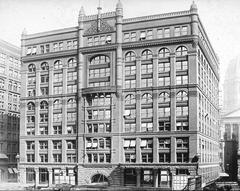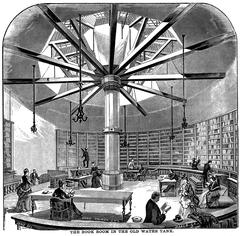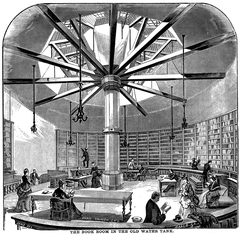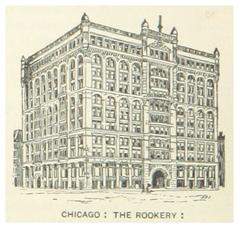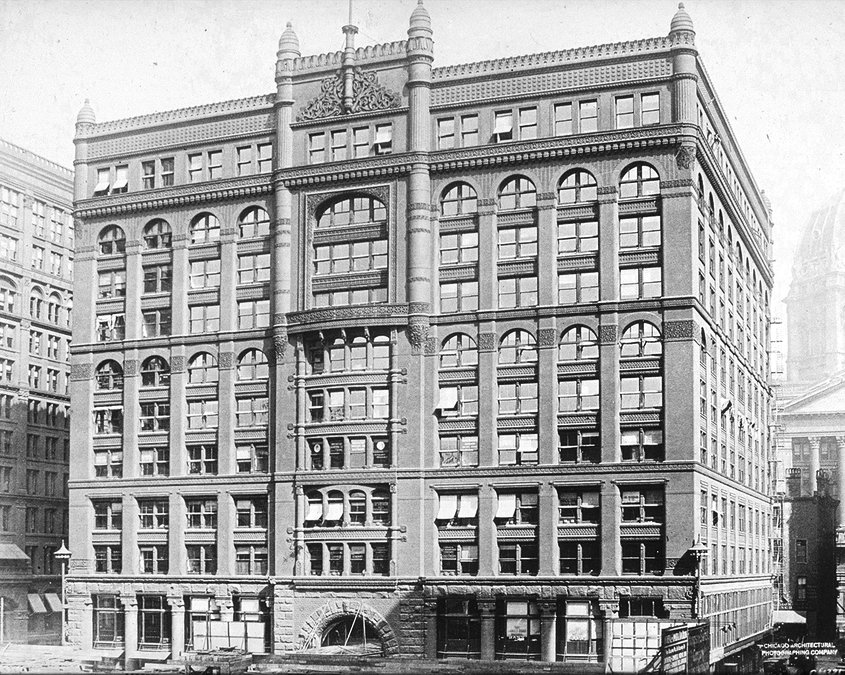
The Rookery Building Chicago: Visiting Hours, Tickets, and Historical Significance
Date: 14/06/2025
Introduction
The Rookery Building is not just one of Chicago’s oldest surviving high-rises, but a living testament to the city’s spirit of innovation and resilience. Erected in 1888 on a site tied to the aftermath of the Great Chicago Fire, this architectural marvel stands at 209 South LaSalle Street in the heart of the Loop district. The building’s rich history, blend of Romanesque and Queen Anne styles, and the transformative touch of Frank Lloyd Wright make it a must-visit for anyone interested in architecture, history, or urban culture (The Rookery Building; Chicago Landmarks; Frank Lloyd Wright Trust).
Table of Contents
- Origins and Naming of the Rookery Building
- Commission and Construction (1885–1888)
- Architectural Significance and Innovations
- Frank Lloyd Wright’s 1905 Renovation
- Preservation, Sustainability, and Modern Recognition
- Visitor Information: Hours, Tickets, and Tours
- Accessibility and Getting There
- Nearby Attractions and Events
- Architectural Highlights
- Frequently Asked Questions (FAQ)
- Cultural and Economic Impact
- Summary and Practical Tips
- References and Further Reading
Origins and Naming of the Rookery Building
The Rookery’s name is rooted in its colorful past. After the Great Chicago Fire of 1871, the site hosted temporary city offices and a water tank, both hastily constructed and soon home to flocks of birds—hence, “the rookery.” The moniker stuck, later referenced with humor by architects and developers. John Root even designed open-mouthed crows into the building’s ornamentation, honoring this legacy (The Rookery Building: Did You Know?; Chicago Landmarks).
Commission and Construction (1885–1888)
Commissioned in 1885 by the Central Safety Deposit Company, architects Daniel Burnham and John Wellborn Root created a revolutionary office building for Chicago’s evolving financial district. The Rookery, completed in 1888, stood at the forefront of skyscraper technology, combining traditional masonry with an innovative iron skeletal structure. Its 11 stories made it one of the world’s tallest and most advanced buildings at the time (The Rookery Building: Our Story; Chicago Landmarks).
Architectural Significance and Innovations
The Rookery’s design bridges eras: its exterior combines Romanesque and Queen Anne styles—seen in red brick, granite, terra cotta details, and rhythmic arcades—while the interior showcases a breathtaking two-story light court with a glass skylight. Burnham and Root’s hybrid system paired heavy masonry with an internal iron frame, allowing greater height and open floor plans (The Rookery Building: Our Story; Wikipedia; The Rookery Building).
Structural Innovation:
Root’s grillage foundation—iron rails crisscrossed and encased in concrete—distributed the building’s weight over Chicago’s soft soil, an engineering feat at the time.
The Light Court:
The central light court, with its iron framework and glass ceiling, floods the building with natural light, enhancing worker comfort and setting a precedent for future office designs (EAA Architecture).
Oriel Staircase:
A cast-iron, spiral oriel staircase—accessible on guided tours—exemplifies both function and beauty.
Frank Lloyd Wright’s 1905 Renovation
In 1905, Frank Lloyd Wright was commissioned to modernize the lobby and light court. His Prairie School vision introduced white marble cladding, geometric patterns, bronze fixtures, and prismatic glass chandeliers. Wright’s renovations harmonized with Burnham and Root’s exuberance, creating a luminous, uplifting environment that remains a highlight for visitors (The Rookery Building: Timeline; FLW Trust).
Preservation, Sustainability, and Modern Recognition
Over the decades, the Rookery has been carefully preserved and adapted to modern standards. It was added to the National Register of Historic Places in 1970 and named a Chicago Landmark in 1972. Restoration in the 1990s returned the lobby to Wright’s vision and added a 12th story. In 2014, the Rookery became the world’s oldest high-rise to achieve LEED Gold Certification, reflecting its commitment to sustainability (The Rookery Building: Timeline; Wikipedia).
Visitor Information: Hours, Tickets, and Tours
Visiting Hours:
- Monday–Friday: 7:00 AM – 6:00 PM
- Saturday: 8:00 AM – 2:00 PM
- Closed Sundays and major holidays
Check the official website for current details.
Admission:
Lobby and light court access are free during public hours. Guided tours require advance tickets.
Guided Tours:
Available through the Frank Lloyd Wright Trust, Chicago Architecture Center, and other providers. Tours generally last 30–45 minutes and include exclusive spaces such as the oriel staircase and Burnham Library. Prices typically range from $13 to $25.
Photography:
Personal photography is allowed in public spaces; tripods and commercial shoots require permission.
Accessibility and Getting There
Wheelchair Accessibility:
The Rookery is fully accessible, with ramps and elevators serving all public areas. For special accommodations, contact tour providers in advance.
Location:
209 South LaSalle Street, Chicago, IL 60604
Public Transit:
CTA bus routes and ‘L’ train lines (Blue, Red, Brown, Orange, Pink, Purple) serve the area. The Quincy/Wells and LaSalle/Van Buren stations are nearby.
Parking:
Multiple garages are available in the Loop, but parking can be limited and expensive during peak hours.
Nearby Attractions and Events
Enhance your visit by exploring:
- Chicago Board of Trade Building (across the street)
- Willis (Sears) Tower (two blocks west)
- Art Institute of Chicago (10-minute walk)
- Millennium Park (15-minute walk)
- Monadnock Building
Check the Rookery’s website for special events, architectural talks, and occasional exhibitions.
Architectural Highlights
-
Light Court:
Marvel at the interplay of glass, marble, and ironwork under a soaring skylight. -
Frank Lloyd Wright’s Lobby:
Note the geometric marble patterns, gilded columns, and original bronze fixtures. -
Oriel Staircase:
Observe the spiral ironwork, a masterpiece of late 19th-century craftsmanship. -
Façade Details:
Look for carved birds—Root’s tribute to the building’s name and origins.
Frequently Asked Questions (FAQ)
Q: What are the Rookery Building visiting hours?
A: Monday–Friday: 7:00 AM – 6:00 PM; Saturday: 8:00 AM – 2:00 PM; closed Sundays and holidays.
Q: Is there an admission fee?
A: Lobby access is free; guided tours require a ticket.
Q: Are guided tours available?
A: Yes, via the Frank Lloyd Wright Trust and Chicago Architecture Center.
Q: Is the building wheelchair accessible?
A: Yes, with ramps and elevators.
Q: Can I photograph inside the Rookery?
A: Personal photography is allowed; commercial shoots require permission.
Q: Can I visit the Rookery on weekends?
A: The lobby is closed on Sundays; Saturday hours are limited.
Cultural and Economic Impact
Architectural and Urban Influence:
The Rookery anchors Chicago’s identity as a center of design innovation. It has influenced generations of architects and played a role in planning the 1893 World’s Columbian Exposition (Frank Lloyd Wright Sites).
Economic Contributions:
As a key tourist destination, the Rookery supports local businesses, draws thousands annually, and contributes to the Loop’s vibrancy (Chicago Cultural Plan 2012).
Community Engagement:
Educational programs and public tours foster appreciation for Chicago’s architecture, aligning with broader cultural goals of accessibility and civic pride.
Summary and Practical Tips
- Best time to visit: Early mornings on weekdays are quieter.
- Tour booking: Reserve tickets in advance, especially in summer.
- Visit duration: Allow 30–60 minutes; guided tours may take longer.
- Nearby dining: The Loop offers many restaurants and cafés within walking distance.
- Plan ahead: Check for special events or private functions that may restrict access.
The Rookery is a cornerstone of Chicago’s architectural story—its legacy is visible in every detail, from Root’s foundation to Wright’s luminous lobby. Don’t miss this essential stop on your Chicago itinerary.
References and Further Reading
- The Rookery Building: Did You Know?
- Chicago Landmarks
- The Rookery Building: Our Story
- Wikipedia: Rookery Building
- EAA Architecture: Rookery Building Chicago
- Frank Lloyd Wright Trust: Rookery Tour
- Architecture.org: Rookery Building Tours
- Chicago Cultural Plan 2012
- Time Out Chicago: Best Architecture Tours
- GPSmyCity: Loop District Architecture Walking Tour
For more tips, downloadable audio guides, and the latest updates on Chicago’s landmarks, download the Audiala app and follow us on social media.
